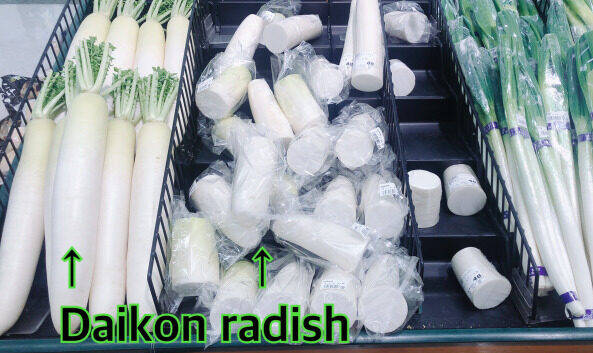
What’s the Daikon radish? What kind of dishes use it for?
Daikon radish is now commonly eaten in Asia, but it is said that the origin of daikon radish was introduced from ancient Egypt in ancient times.
It is the most produced vegetable in Japan.
It’s a winter vegetable.
Daikon Radish is full of nutrition such as vitamins, folic acid, and calcium, and it is said that it used to have a role as a medicine in Japan.
There are many cooking methods, and daikon radishes that show various faces.
On this page, I would like to tell you a lot about the charm of daikon radish!
Daikon radish is root
Daikon radish is the root. It has a fibrous, but this is the proof of its roots. The white part is the root, and when you go up, there is a stem part without a beard, and there are leaves.
There is no nutrition in the radish body
The main body here is the white part, I mean, the root part. Actually, that part is not very nutritious.
It is the leaves that are nutritious. The vitamins, folic acid, and calcium mentioned above are all contained in the leaves.
The tip of radish is spicy
The taste of daikon radish changes when grated daikon radish.
The bottom is spicy, the middle and the top are not spicy even if grated.

By the way, why does radish become spicy when grated?
That is because the radish protects itself from the enemy. (Insects, moles, etc.
When a cell breaks, it releases a spicy ingredient, isothiocyanate, and tells the enemy, “Don’t eat!”
This has the characteristic that the spiciness will fly away when it touch the air.
Therefore, by grated it with special radish grater (called Oniorosi) and when you eat it, the isothiocyanate is immediately dispersed in your mouth, and you can feel the original spiciness of daikon radish.
In other words, if you grate it finely, it will touch the air immediately, so it is not spicy. By destroying the cells in the mouth, you can feel the spiciness more.You can experience the spiciness by chewing well without grating it.
Hey Mr.Daikon, you don’t want to be eatten. When I think so, it’s painful to eat you. I really appreciate you.
How to choose delicious daikon radish
Choose radishes that are heavy, taut, and fresh.
Recommended cooking method for each part of radish
Upper part of daikon radish
The upper part of the daikon radish is crispy, so it is suitable for salads eaten raw.
Middle part of daikon radish
The middle of the daikon radish is a sweet and soft part. It is a recommended part for simmered dishes.
Lower part of daikon radish
The lower part of the radish is a place where you can enjoy the spiceness. Grated it and use it for cooking.
Radish skin and leaves are nutritious
It’s common in vegetables, but in fact, the skin and leaves are nutritious and very delicious, so please try it! Radish has no place to throw away.
The leaves are delicious even if they are fried or pickled. Stir fry in oil or put in fried rice. Depending on the idea, the food will be very delicious.
In terms of skin, you can make dried daikon! Of course, it is delicious even you cut and stir-fry as it is. But if you made dried daikon, you can enjoy the crispy feeling and Calcium, folic acid, dietary fiber, and potassium are significantly increased compared to raw.
Click here for how to make dried daikon.
How to save daikon radish
Most of the ingredients of radish are water, so if you leave it, it will dry out.
Cut the leaves and body, In terms of body, cut them in half to fit in the refrigerator, and store them. If you don’t use the leaves immediately, boil them and store them for about 2 weeks.
In Japan, they are often cut and sold.
Let’s eat daikon radish!
Daikon radish can really be used in various dishes. Not only simmered dishes, but also miso soup, curry, stew, and salad.
How about daikon radish dishes on the menu tonight?
(The image is Handmade creamy white sauce that doesn’t fail! Cream stew)





